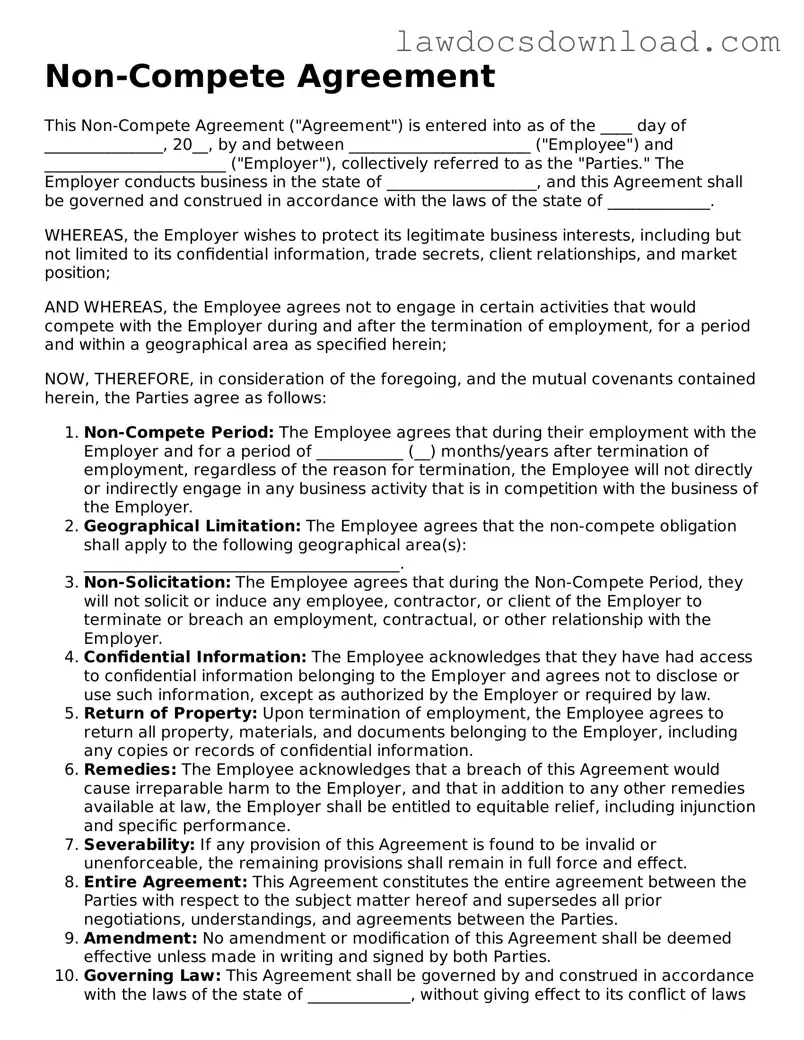Non-Compete Agreement
This Non-Compete Agreement ("Agreement") is entered into as of the ____ day of _______________, 20__, by and between _______________________ ("Employee") and _______________________ ("Employer"), collectively referred to as the "Parties." The Employer conducts business in the state of ___________________, and this Agreement shall be governed and construed in accordance with the laws of the state of _____________.
WHEREAS, the Employer wishes to protect its legitimate business interests, including but not limited to its confidential information, trade secrets, client relationships, and market position;
AND WHEREAS, the Employee agrees not to engage in certain activities that would compete with the Employer during and after the termination of employment, for a period and within a geographical area as specified herein;
NOW, THEREFORE, in consideration of the foregoing, and the mutual covenants contained herein, the Parties agree as follows:
- Non-Compete Period: The Employee agrees that during their employment with the Employer and for a period of ___________ (__) months/years after termination of employment, regardless of the reason for termination, the Employee will not directly or indirectly engage in any business activity that is in competition with the business of the Employer.
- Geographical Limitation: The Employee agrees that the non-compete obligation shall apply to the following geographical area(s): ________________________________________.
- Non-Solicitation: The Employee agrees that during the Non-Compete Period, they will not solicit or induce any employee, contractor, or client of the Employer to terminate or breach an employment, contractual, or other relationship with the Employer.
- Confidential Information: The Employee acknowledges that they have had access to confidential information belonging to the Employer and agrees not to disclose or use such information, except as authorized by the Employer or required by law.
- Return of Property: Upon termination of employment, the Employee agrees to return all property, materials, and documents belonging to the Employer, including any copies or records of confidential information.
- Remedies: The Employee acknowledges that a breach of this Agreement would cause irreparable harm to the Employer, and that in addition to any other remedies available at law, the Employer shall be entitled to equitable relief, including injunction and specific performance.
- Severability: If any provision of this Agreement is found to be invalid or unenforceable, the remaining provisions shall remain in full force and effect.
- Entire Agreement: This Agreement constitutes the entire agreement between the Parties with respect to the subject matter hereof and supersedes all prior negotiations, understandings, and agreements between the Parties.
- Amendment: No amendment or modification of this Agreement shall be deemed effective unless made in writing and signed by both Parties.
- Governing Law: This Agreement shall be governed by and construed in accordance with the laws of the state of _____________, without giving effect to its conflict of laws principles.
IN WITNESS WHEREOF, the Parties have executed this Non-Compete Agreement as of the date first above written.
Employee Signature: ___________________________________ Date: _______________
Employer Signature: ___________________________________ Date: _______________
